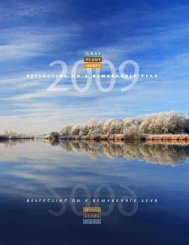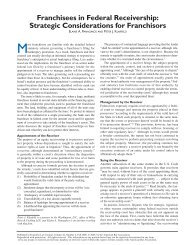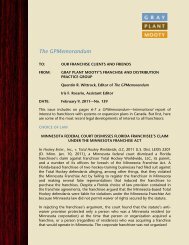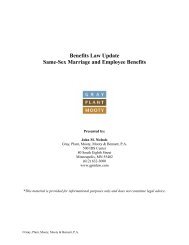Los Angeles Lawyer October 2008 - Gray Plant Mooty
Los Angeles Lawyer October 2008 - Gray Plant Mooty
Los Angeles Lawyer October 2008 - Gray Plant Mooty
You also want an ePaper? Increase the reach of your titles
YUMPU automatically turns print PDFs into web optimized ePapers that Google loves.
___ S.W. 3d ___, <strong>2008</strong> WL 1960215 (Mo. App. S.D.<br />
May 7, <strong>2008</strong>).<br />
38 People v. Wheeler, 22 Cal. 3d 258, 263 (1978).<br />
39<br />
Id.; see also People v. Lenix, 44 Cal. 4th 602, 621<br />
(<strong>2008</strong>) (“Both court and counsel bear responsibility for<br />
creating a record that allows for meaningful review.”).<br />
40<br />
Batson v. Kentucky, 476 U.S. 79, 97 (1986).<br />
41<br />
See Boyd v. Newland, 467 F. 3d 1139, 1149-50<br />
(9th Cir. 2006).<br />
42<br />
See id. at 1148-50. At the time Boyd was decided,<br />
California courts generally had held that “comparative<br />
juror analysis can take place on appeal only when the<br />
trial court engaged in such analysis in the first instance.”<br />
Boyd, 467 F. 3d at 1148 (citing People v. Johnson, 30<br />
Cal. 4th 1302 (2003); People v. Cornwell, 37 Cal. 4th<br />
50 (2005)). This year, however, the California Supreme<br />
Court rejected this approach, holding that, at least<br />
during the third Batson step, comparative juror analysis<br />
“must be performed on appeal even when such an<br />
analysis was not conducted below.” Lenix, 44 Cal. 4th<br />
at 607. Boyd’s approach continues to differ with<br />
California courts on two issues. First, as Boyd notes,<br />
“some California courts have questioned whether comparative<br />
juror analysis is similarly appropriate at the<br />
first Batson step, where the prosecution has not voiced<br />
its rationales for the strikes, instead of at the third<br />
Batson step.” Boyd, 467 F. 3d at 1149 (citing People<br />
v. <strong>Gray</strong>, 37 Cal. 4th 168 (2005); People v. Guerra, 37<br />
Cal. 4th 1067 (2006)). Second, though Boyd does not<br />
limit reliance on events occurring after the challenged<br />
peremptory, California courts take a different view,<br />
holding that “the trial court’s finding is reviewed on the<br />
record as it stands at the time the Wheeler/Batson ruling<br />
is made. If the defendant believes that subsequent<br />
events should be considered by the trial court, a renewed<br />
objection is required to permit appellate consideration<br />
of these subsequent developments.” Lenix, 44<br />
Cal. 4th at 624.<br />
43<br />
See United States v. Vasquez-Lopez, 22 F. 3d 900,<br />
902 (9th Cir. 1994) (“We have held that the<br />
Constitution forbids striking even a single prospective<br />
juror for a discriminatory purpose.”). It is equally<br />
clear, however, that “just as one is not a magic number<br />
which establishes the absence of discrimination, the<br />
fact that the juror was the one Black member of the<br />
venire does not, in itself, raise an inference of discrimination.<br />
Using peremptory challenges to strike<br />
Blacks does not end the inquiry; it is not per se unconstitutional,<br />
without more, to strike one or more Blacks<br />
from the jury. A district court must consider the relevant<br />
circumstances surrounding a peremptory challenge.”<br />
Id. (citations omitted).<br />
44<br />
Abu-Jamal v. Horn, 520 F. 3d 272, 290 (3d Cir.<br />
<strong>2008</strong>).<br />
45<br />
Id. at 291.<br />
46<br />
Id. at 291-92.<br />
47<br />
Id. at 292. The court noted that the defendant “had<br />
not pointed to any improper statements or questions<br />
by the prosecution during voir dire” that could serve<br />
to make out a prima facie case despite the noted record<br />
failings regarding the makeup of the venire. Id. at 289.<br />
48<br />
Purkett v. Elem, 514 U.S. 765, 767-68 (1995) (per<br />
curiam).<br />
49<br />
Id. at 766.<br />
50<br />
Snyder v. Louisiana, 128 S. Ct. 1203, 1208-09<br />
(<strong>2008</strong>).<br />
51<br />
Hernandez v. New York, 500 U.S. 352, 359 (1991).<br />
52<br />
United States v. Omoruyi, 7 F. 3d 880 (9th Cir.<br />
1993).<br />
53 Id.<br />
54 Id.<br />
55 Id.<br />
56 Commonwealth v. Odell, 34 Mass. App. Ct. 100,<br />
101-02, 607 N.E. 2d 423, 425 (1993).<br />
57 Alverio v. Sam’s Warehouse Club, Inc., 253 F. 3d<br />
933, 940-41 (7th Cir. 2001).<br />
TRUST DEED FORECLOSURES<br />
“Industry Specialists For Over 18 Years”<br />
At Witkin & Eisinger we specialize in the Non-Judicial<br />
Foreclosure of obligations secured by real property<br />
or real and personal property (mixed collateral).<br />
When your client needs a foreclosure done professionally<br />
and at the lowest possible cost, please call us at:<br />
1-800-950-6522<br />
We have always offered free advice to all attorneys.<br />
WITKIN<br />
&EISINGER, LLC<br />
RICHARD G. WITKIN, ESQ. ◆ CAROLE EISINGER<br />
(949) 388-0524<br />
<strong>Los</strong> <strong>Angeles</strong> <strong>Lawyer</strong> <strong>October</strong> <strong>2008</strong> 33







